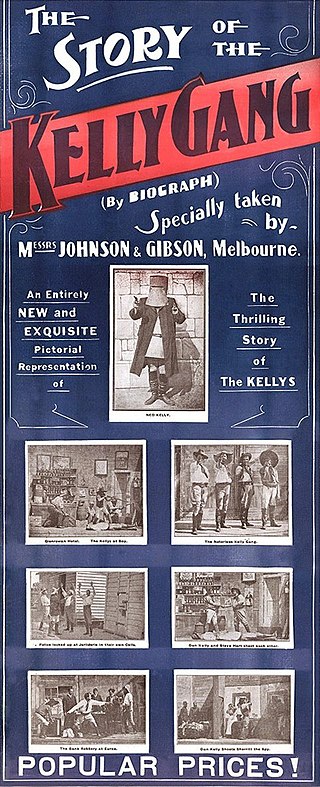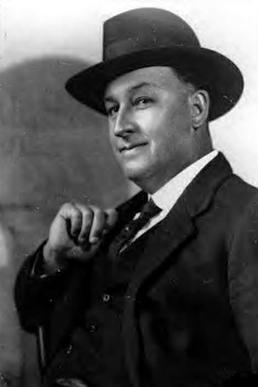Related Research Articles

The Story of the Kelly Gang is a 1906 Australian bushranger film that traces the exploits of 19th-century bushranger and outlaw Ned Kelly and his gang. It was directed by Charles Tait and shot in and around the city of Melbourne. The original cut of this silent film ran for more than an hour with a reel length of about 1,200 metres (4,000 ft), making it the longest narrative film yet seen in the world. It premiered at Melbourne's Athenaeum Hall on 26 December 1906 and was first shown in the United Kingdom in January 1908. A commercial and critical success, it is regarded as the origin point of the bushranging drama, a genre that dominated the early years of Australian film production. Since its release, many other films have been made about the Kelly legend.

Cinesound Productions Pty Ltd was an Australian feature film production company, established in June 1931, Cinesound developed out of a group of companies centred on Greater Union Theatres, that covered all facets of the film process, from production, to distribution and exhibition.

William Joseph Lincoln was an Australian playwright, theatre manager, film director and screenwriter in the silent era. He produced, directed and/or wrote 23 films between 1911 and 1916.

John F. Gavin was a pioneer Australian film actor and director, one of the early filmmakers of the 1910s. He is best known for making films about bushrangers such as Captain Thunderbolt, Captain Moonlite, Ben Hall and Frank Gardiner. Known informally as 'Jack', Gavin worked in collaboration with his wife Agnes, who scripted many of his films.

Herbert Sydney Wilcox CBE was a British film producer and director.

Raymond Longford was a prolific Australian film director, writer, producer, and actor during the silent era. Longford was a major director of the silent film era of the Australian cinema. He formed a production team with Lottie Lyell. His contributions to Australian cinema with his ongoing collaborations with Lyell, including The Sentimental Bloke (1919) and The Blue Mountains Mystery (1921), prompted the Australian Film Institute's AFI Raymond Longford Award, inaugurated in 1968, to be named in his honour.

Francis William Thring III, better known as F. W. Thring, was an Australian film director, producer, and exhibitor. He has been credited with the invention of the clapperboard.

Moonlite is a 1910 bushranger film about Captain Moonlite, played by John Gavin, who also directed. It was also known as Captain Moonlite and is considered a lost film.
Ben Hall and his Gang is a 1911 Australian film about the bushranger Ben Hall, played by John Gavin, who also directed. It is considered a lost film.
Agnes Gavin (1872–1947), was an Australian actor and screenwriter in the silent film era. She worked in collaboration with her husband John Gavin throughout her career. She wrote the majority of his films and was arguably the first specialist screenwriter in the history of the Australian film industry. In newspapers she was advertised as the "well known picture dramatizer" and was praised for creating "cleverly constructed stories". Many of her films are considered lost.
Keane of Kalgoorlie, or a Story of the Sydney Cup is a 1911 Australian silent film set in the racing and gambling circles of Sydney, based on a popular play by Edward William O'Sullivan and Arthur Wright, adapted from the novel by Wright.

Trooper O'Brien is a 1928 Australian silent film from the team of John and Agnes Gavin. It was a melodrama set during the "Ned Kelly era" about an orphaned girl raised by a policeman in the bush. It is one of the rare early Australian films that still exist in its entirety.
It Is Never Too Late to Mend is an Australian feature-length silent film written and directed by W. J. Lincoln. It was based on a stage adaptation of the popular 1865 novel It Is Never Too Late to Mend: A Matter-of-Fact Romance by Charles Reade about the corrupt penal system in Australia. It was called "certainly one of the best pictures ever taken in Australia."
Charles Cozens Spencer was a British-born film exhibitor and producer, who was a significant figure in the early years of the Australian film industry. He produced films under the name Spencer's Pictures and was an early backer of the films of Raymond Longford. He was also instrumental in the creation of "The Combine".
The Life Story of John Lee, or the Man They Could Not Hang is a 1912 Australian silent film based on a stage play about the true life story of John Babbacombe Lee.

Stanley Sadler Crick was an Australian film producer, distributor and politician. He joined the Melbourne office of Pathe Freres and became manager of the Sydney branch in 1909. He went into production, first in partnership with Herbert Finlay then helping establish the Australian Photo-Play Company.

William Alfred Gibson was an Australian film producer and exhibitor best known for his collaboration with Millard Johnson. He was one of the producers of The Story of the Kelly Gang (1906) and helped establish Amalgamated Pictures.
The Australian Photo-Play Company was a short-lived but highly productive Australian film production company which operated from 1911 to 1912.
The bushranger ban was a ban on films about bushrangers that came in effect in Australia in 1911–12. Films about bushrangers had been the most popular genre of local films ever since The Story of the Kelly Gang (1906). Governments were worried about the influence this would have on the population and bans against films depicting bushrangers were introduced in South Australia (1911), New South Wales and Victoria (1912).

Jennifer "Jennie" Boddington was an Australian film director and producer, who was first curator of photography at the National Gallery of Victoria in Melbourne (1972–1994), and researcher.
References
- ↑ Herbert Finlay at National Film and Sound Archive
- ↑ Andrew Pike and Ross Cooper, Australian Film 1900–1977: A Guide to Feature Film Production, Melbourne: Oxford University Press, 1998, 13
- ↑ "AUSTRALIAN FILMS". The Evening News . Sydney: National Library of Australia. 15 September 1927. p. 14. Retrieved 21 November 2014.
- ↑ "QUOTA FAVORED". The Sun . No. 5259. New South Wales, Australia. 15 September 1927. p. 14 (FINAL EXTRA). Retrieved 2 December 2023– via National Library of Australia.